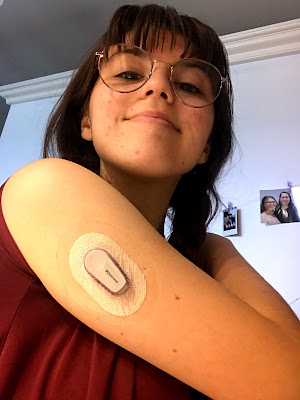Insulin Pumps
Good afternoon internet! Yesterday was so cold and wet, but one thing kept a smile on my face despite the dreary weather. Yesterday morning I had my insulin pump information session at the hospital! Why is that such a great thing? Listen and I'll tell you.
For the first year after you are diagnosed with Type 1 Diabetes, you control your blood glucose numbers using insulin. You get insulin through MDI (multiple daily injections). But once you celebrate your one year dia-versary, you are eligible to receive government funding for an insulin pump.
What is an insulin pump? An insulin pump is a device that is injected into your body with a needle and, hence the name insulin pump, pumps insulin into your blood stream instead of you having to inject it.
But, just like the Freestyle Libre CGM and Dexcom G5 Mobile CGM, the needle DOES NOT stay in your body for more than 5 minutes. The needle inserts a small plastic tube called a cannula that the insulin flows through, then it comes out again. A sensor sits on your skin held in by some adhesive tape.
Sounds pretty great, huh? I think so too! I hate doing injections. That's why I was so excited for this information session.
At the pump information session, you basically learn about all the different types of pumps that exist -how to use them, pros and cons, special features, how to set up a sensor site, and you fill out a lot of paperwork.
Well, in my case my parents filled out a lot of paperwork because I'm only twelve, but I would imagine that if you are over eighteen then you would be the one filling out paperwork. But we're getting sort of off topic, back to the point!
What is an insulin pump? An insulin pump is a device that is injected into your body with a needle and, hence the name insulin pump, pumps insulin into your blood stream instead of you having to inject it.
But, just like the Freestyle Libre CGM and Dexcom G5 Mobile CGM, the needle DOES NOT stay in your body for more than 5 minutes. The needle inserts a small plastic tube called a cannula that the insulin flows through, then it comes out again. A sensor sits on your skin held in by some adhesive tape.
Sounds pretty great, huh? I think so too! I hate doing injections. That's why I was so excited for this information session.
At the pump information session, you basically learn about all the different types of pumps that exist -how to use them, pros and cons, special features, how to set up a sensor site, and you fill out a lot of paperwork.
Well, in my case my parents filled out a lot of paperwork because I'm only twelve, but I would imagine that if you are over eighteen then you would be the one filling out paperwork. But we're getting sort of off topic, back to the point!
As you might know, Animas recently discontinued their pumps, so I had two companies to choose from - Omnipod or Medtronic.
I found out a lot about each company and their latest models, and these were some of the most major points that caught my attention:
Omnipod and Medtronic have a lot of small differences, but they basically do the same thing. However, the biggest difference in my opinion is that Medtronic has tubing, and Omnipod doesn't.
Having tubing basically means that with Omnipod, you plug instructions into the PDM on how much insulin to give, and it sends a message to your sensor (known as a 'pod' with Omnipod) and it delivers that amount of insulin through the cannula.
However with Medtronic, you plug the instructions into the PDM, and the insulin goes through a long tube connected from the PDM to your sensor site and flows through the cannula into your blood stream.
In order for you to get your insulin through the tubing and into your blood stream, you need to wear the PDM on your pants using a clip so that the tubing can stay connected with the sensor site.
Now, because Medtronic's PDM isn't water proof (neither is Omnipod's, but that's not the point here), it can't get wet. But what about when you are taking a shower, or going to a pool party?
This basically means that you can wear Omnipod in the shower, while you're swimming, or when you do anything that has to do with water. But with Medtronic, you need to disconnect your pump tubing and device from the sensor while you are in contact with water.
That was a big factor in my decision because constantly disconnecting and reconnecting pump tubing seems like a big hassle.
Also, I don't want to be connected to a tube because it will be more easily noticed by the public, so it is more likely for people to ask questions. And if there is a tube sticking out of you, it can get caught on stuff and potentially rip out your sensor. I have a feeling that I would not enjoy that.
 For these reasons, I have chosen to get an Omnipod as my pump! I am so excited for this very complicated disease to become a little easier to manage! The Omnipod PDM will be mailed to my house in about one month, and then it's back to the hospital for a pump training session!
For these reasons, I have chosen to get an Omnipod as my pump! I am so excited for this very complicated disease to become a little easier to manage! The Omnipod PDM will be mailed to my house in about one month, and then it's back to the hospital for a pump training session!
I found out a lot about each company and their latest models, and these were some of the most major points that caught my attention:
- Omnipod has a small sensor, although Medtronic's is smaller. Omnipod's sensors are about the same size as a quarter of the palm of your hand, whereas Medtronic's sensors are about the size of a 25 cent coin.
- I prefer Omnipod's insertion process over Medtronic's. Not because Medtronic's method isn't good, but because I've used other products with similar insertion processes that didn't quite agree with me.
- Omnipod's PDM (personal diabetes manager) has a large screen that is easy to navigate and the instructions that appear on the screen are clear and easy to follow. Medtronic's PDM is just a little smaller, but the screen itself is very small and I found it hard to read/understand.
Omnipod and Medtronic have a lot of small differences, but they basically do the same thing. However, the biggest difference in my opinion is that Medtronic has tubing, and Omnipod doesn't.
Having tubing basically means that with Omnipod, you plug instructions into the PDM on how much insulin to give, and it sends a message to your sensor (known as a 'pod' with Omnipod) and it delivers that amount of insulin through the cannula.
However with Medtronic, you plug the instructions into the PDM, and the insulin goes through a long tube connected from the PDM to your sensor site and flows through the cannula into your blood stream.
In order for you to get your insulin through the tubing and into your blood stream, you need to wear the PDM on your pants using a clip so that the tubing can stay connected with the sensor site.
Now, because Medtronic's PDM isn't water proof (neither is Omnipod's, but that's not the point here), it can't get wet. But what about when you are taking a shower, or going to a pool party?
This basically means that you can wear Omnipod in the shower, while you're swimming, or when you do anything that has to do with water. But with Medtronic, you need to disconnect your pump tubing and device from the sensor while you are in contact with water.
That was a big factor in my decision because constantly disconnecting and reconnecting pump tubing seems like a big hassle.
Also, I don't want to be connected to a tube because it will be more easily noticed by the public, so it is more likely for people to ask questions. And if there is a tube sticking out of you, it can get caught on stuff and potentially rip out your sensor. I have a feeling that I would not enjoy that.
 For these reasons, I have chosen to get an Omnipod as my pump! I am so excited for this very complicated disease to become a little easier to manage! The Omnipod PDM will be mailed to my house in about one month, and then it's back to the hospital for a pump training session!
For these reasons, I have chosen to get an Omnipod as my pump! I am so excited for this very complicated disease to become a little easier to manage! The Omnipod PDM will be mailed to my house in about one month, and then it's back to the hospital for a pump training session!
I will write a post about how I am adjusting to life with the Omnipod in a month.
Till next week, Type 1 Warriors!
Thanks for reading this week's post of That Stupid Pancreas!
If there are any questions/comments/concerns, please don't hesitate to email me about it here
Don't forget to check us out on Instagram by clicking here
Or check us out on Google+ by clicking here
Or check us out on Facebook by clicking here
Do you want to get email notifications every time I post something new? Then become part of the family by clicking the subscribe button at the top of the page.
Today's question of the day is...
Do you get your insulin by MDI or through a pump? If you use a pump, what kind do you use and why do you use it? If you don't have a pump, is it because you prefer MDI, or because you are still waiting for your one year dia-versary?
Comment the answers down below!!!



Comments
Post a Comment